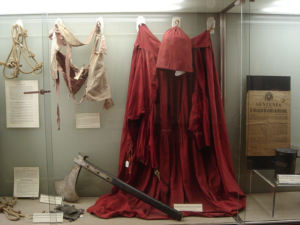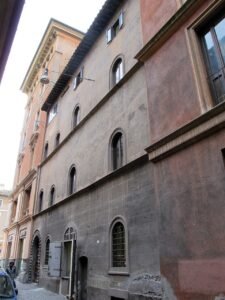

When you think of Rome, you probably picture ruins, fountains, pizza, and popes. But the Eternal City has another legacy — a darker one, soaked in blood and whispered through centuries of stone.
And no figure embodies that dark history quite like Mastro Titta.
He wasn’t a fictional villain or the subject of a ghost story (although… more on that later). He was real. And if you’re feeling brave, you can walk the same streets he once haunted on our Rome Ghost Tour.
But first — here are five facts you should know about the man who executed over 500 people, and somehow remained polite while doing it.
Let’s start with the basics. Mastro Titta’s real name was Giovanni Battista Bugatti, which sounds more like a race car driver than a state executioner. “Mastro Titta” was a nickname — “mastro” meaning “master,” and “Titta” being a variation of his name.
It sounds friendlier than “The Beheader of the Papal States,” but let’s be honest… not by much.

The scarlet cloak and executioner’s axe used by Mastro Titta, preserved at the Museum of Criminology in Rome. Photo Credit: The Archaeologist
Mastro Titta started his job in 1796 — and didn’t stop until 1864. That’s 68 years of cutting people’s lives short. He officially executed 514 people*, keeping careful notes in a red leather journal. Some entries were barely a sentence long: name, method, location. Businesslike. Efficient. Chilling.
*It was supposed to be 516, but 2 others died in their cells on the mornings they were due to be executed – he was probably a little disappointed by this.
Yes, really.
When he wasn’t beheading people with an axe or overseeing hangings and guillotine work, Mastro Titta sold umbrellas and holy water near the Vatican. He lived in the Borgo district and was known as a calm, respectful man.
Just… don’t borrow an umbrella without paying.

Mastro Titta’s house in the Borgo, on Vicolo del Campanile
As executioner, Mastro Titta was banned from entering Rome proper. He could only cross the Ponte Sant’Angelo into the city on days he was “working.” When locals saw him crossing the bridge in his red cloak, it sent a shudder through the crowd.
They’d whisper:
“Mastro Titta has crossed the bridge…”
Which, translated into modern terms, meant: someone’s going to die today.

Ponte Sant’Angelo, the bridge Mastro Titta crossed en route to executions, signaling impending doom to onlookers
Some say Mastro Titta never really left.
There are stories — quiet ones — of a figure in a red cloak seen wandering near the river late at night. He doesn’t speak. He doesn’t move quickly. But his presence is heavy, like a cold wind just before the axe falls.
Want to know the full story?
You’ll have to come hear it in the dark, on our Rome Ghost Tour — where we walk the same streets he once did, and tell the chilling truth behind the legends.
Join the tour. Follow the footsteps. See if you feel that red-cloaked shadow nearby.
Discover the hidden tales of history – the ones you won’t hear in your history class
